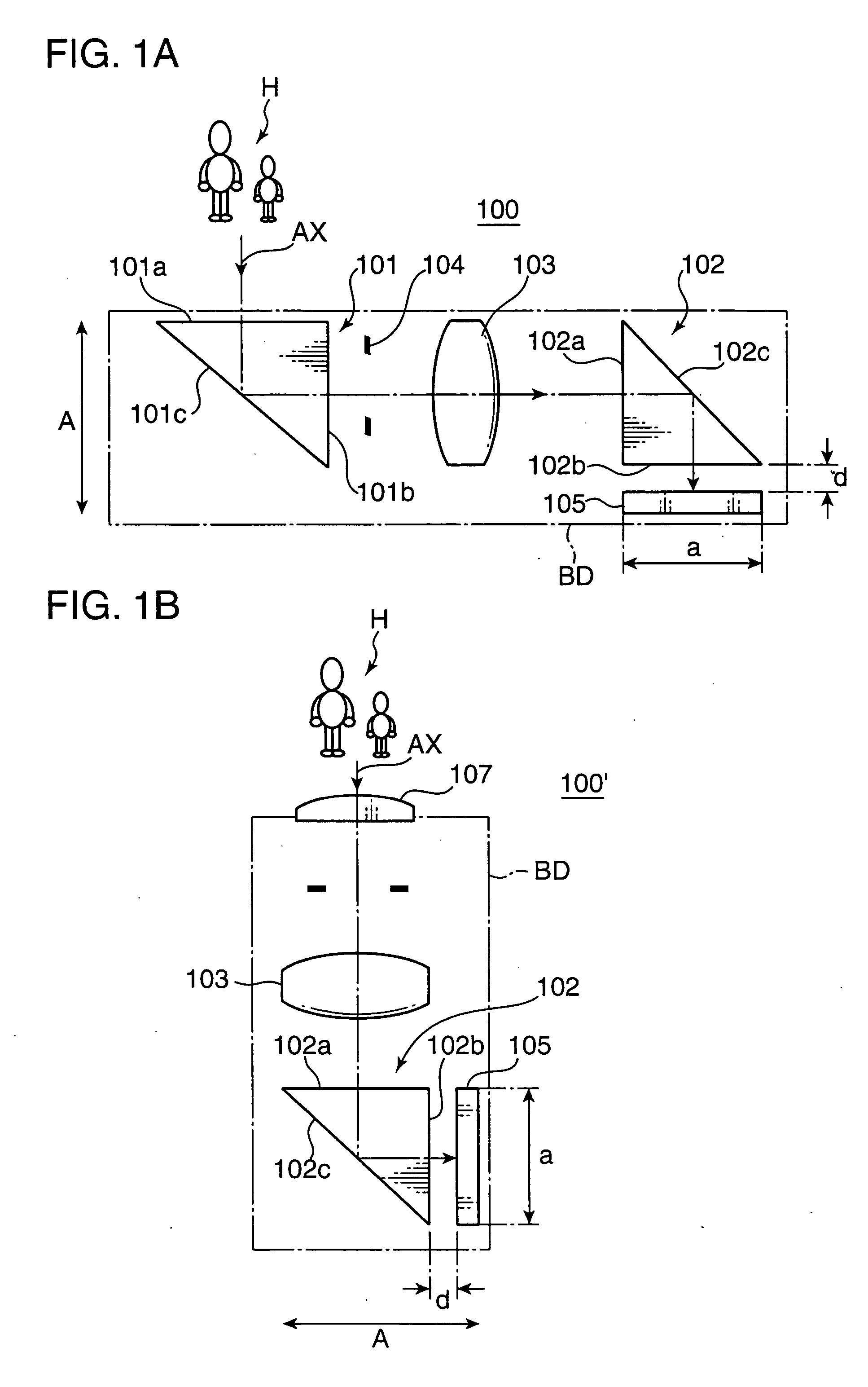Imaging optical system and imaging lens device
a technology of optical system and lens device, which is applied in the field of imaging optical system and imaging lens device, can solve the problems of user failure to release the shutter at the right moment, a certain time to finalize the shooting preparation operation, and increase the cost of the imaging optical system, etc., and achieve the effect of compact imaging optical system and low cos
- Summary
- Abstract
- Description
- Claims
- Application Information
AI Technical Summary
Benefits of technology
Problems solved by technology
Method used
Image
Examples
first embodiment
[0124]FIG. 11 is a cross-sectional view of an arrangement of an imaging optical system 51 as a first embodiment taken along a longitudinal direction of the optical axis (AX) in FIG. 11. As shown in FIG. 11, the imaging optical system 51 has, from the object side along the optical path, a first reflecting prism 1 having a positive optical power as a whole, which corresponds to the incident side prism 101 shown in FIG. 1A, an aperture stop (ST) for regulating the light amount, a first lens element 2 having a positive optical power, a second lens element 3 having a negative optical power, and a second reflecting prism 4 having a positive optical power as a whole, which corresponds to the imaging side prism 102 shown in FIG. 1A. A plane parallel plate 5 and an image sensor 6 are arranged on the side of the second reflecting prism 4 opposite to the second lens element 3.
[0125]FIG. 11, as well as FIGS. 14 and 16 respectively showing a second embodiment and a third embodiment of the inven...
second embodiment
[0132]FIG. 14 is a cross-sectional view of an arrangement of an imaging optical system 52 as a second embodiment taken along a longitudinal direction of the optical axis (AX) in FIG. 14. As shown in FIG. 14, the imaging optical system 52 has, from the object side along the optical path, an aperture stop (ST) for regulating the light amount, a first reflecting prism 7 having a positive optical power as a whole, a first lens element 8 having a negative optical power, and a second reflecting prism 9 having a positive optical power as a whole.
[0133] The first reflecting prism 7 has an incident surface 7a of a positive optical power, an exit surface 7b of a positive optical power, and a planar reflecting surface RL3 arranged on the optical path between the incident surface 7a and the exit surface 7b. The second reflecting prism 9 has an incident surface 9a of a positive optical power, an exit surface 9b of a negative optical power, and a planar reflecting surface RL4 arranged on the opt...
third embodiment
[0135]FIG. 16 is a cross-sectional view of an arrangement of an imaging optical system 53 as a third embodiment taken along a longitudinal direction of the optical axis (AX) in FIG. 16. As shown in FIG. 16, the imaging optical system 53 has, from the object side along the optical path, a first reflecting prism 10 having a positive optical power as a whole, an aperture stop (ST) for regulating the light amount, a first lens element 11 having a positive optical power, a second lens element 12 having a negative optical power, and a second reflecting prism 13 having a positive optical power as a whole.
[0136] The first reflecting prism 10 has an incident surface 10a of a negative optical power, an exit surface 10b of a positive optical power, and a planar reflecting surface RL5 arranged on the optical path between the incident surface 10a and the exit surface 10b. The second reflecting prism 13 has an incident surface 13a of a negative optical power, an exit surface 13b of a positive op...
PUM
 Login to View More
Login to View More Abstract
Description
Claims
Application Information
 Login to View More
Login to View More - R&D
- Intellectual Property
- Life Sciences
- Materials
- Tech Scout
- Unparalleled Data Quality
- Higher Quality Content
- 60% Fewer Hallucinations
Browse by: Latest US Patents, China's latest patents, Technical Efficacy Thesaurus, Application Domain, Technology Topic, Popular Technical Reports.
© 2025 PatSnap. All rights reserved.Legal|Privacy policy|Modern Slavery Act Transparency Statement|Sitemap|About US| Contact US: help@patsnap.com



